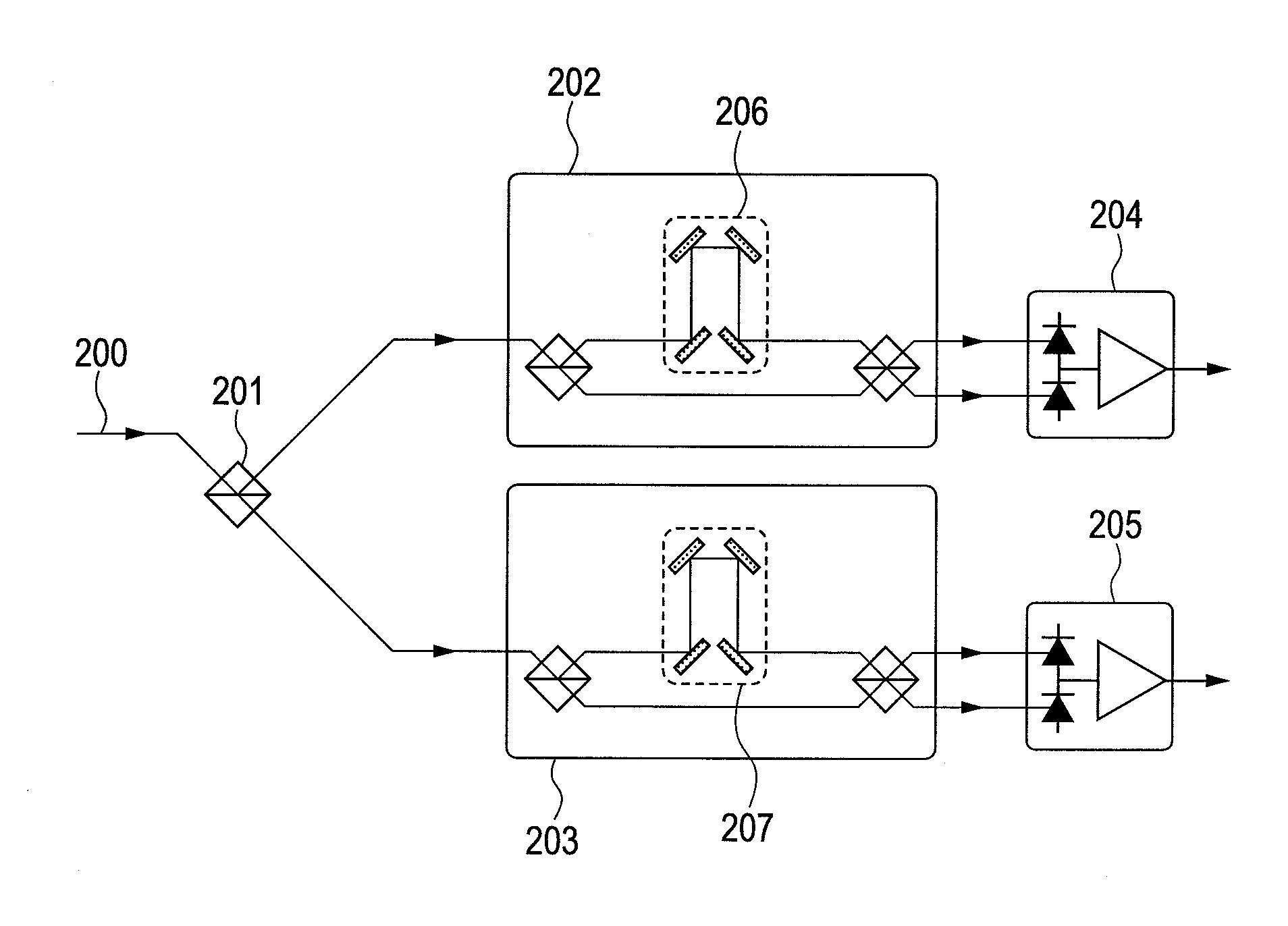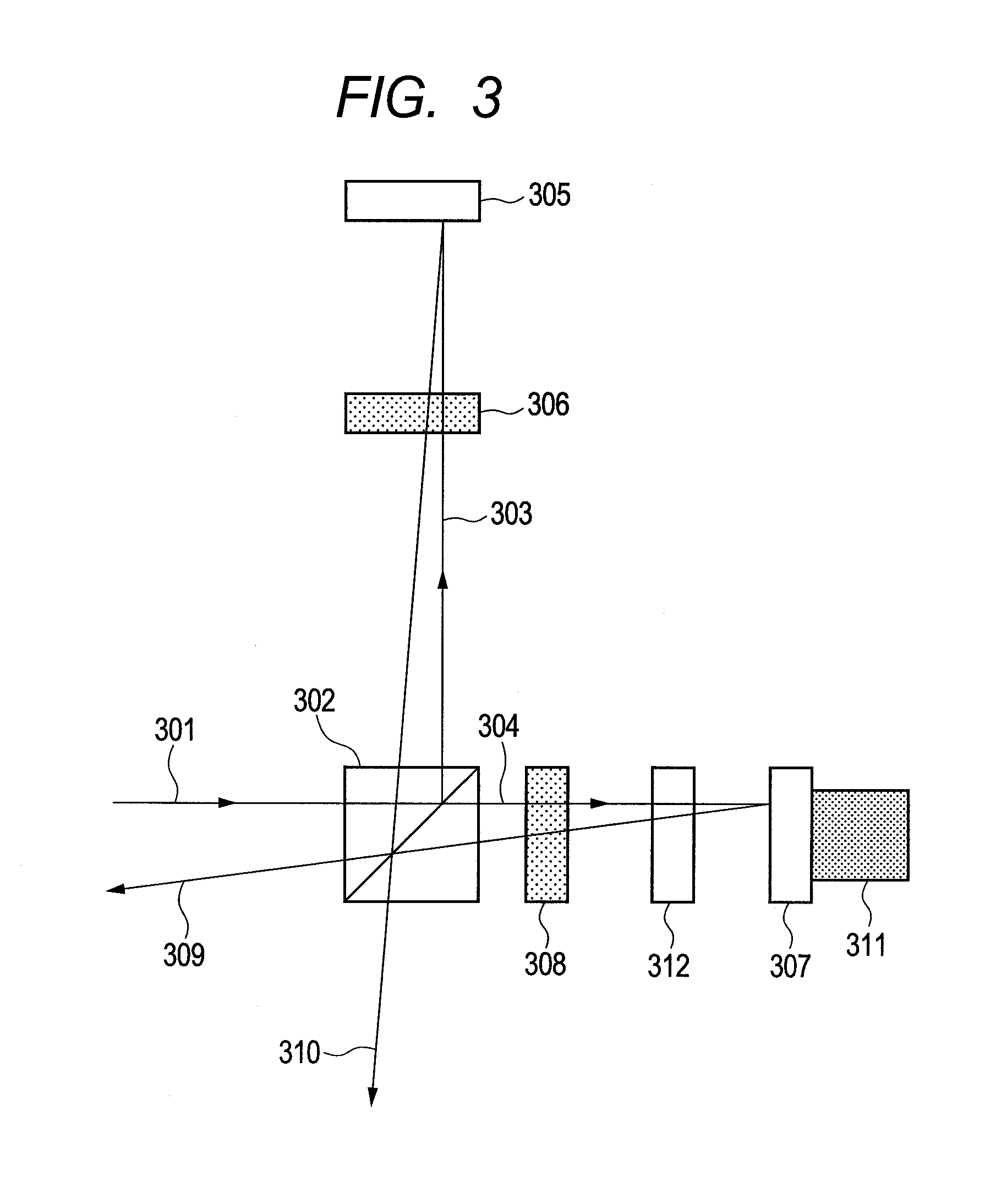Interferometer, demodulator, and optical communication module
a technology of optical communication module and interferometer, which is applied in the direction of optical elements, instruments, transmission monitoring, etc., can solve the problems of shortening the optical phase modulation amount for a prescribed drive voltage, and shortening the system activation time, so as to achieve faster optical phase modulation speed, shorten the life of the device, and reduce the effect of strok
- Summary
- Abstract
- Description
- Claims
- Application Information
AI Technical Summary
Benefits of technology
Problems solved by technology
Method used
Image
Examples
first embodiment
[0048]An embodiment of the present invention is described below with reference to FIG. 3.
[0049]FIG. 3 shows a basic embodiment of the present invention. A modulated signal 301 that has been DPSK-modulated enters a half beam splitter 302 and is split into a first split light 303 and a second split light 304 at an intensity ratio of 1:1. The first split light 303 enters a mirror 305 at approximately 90 degrees and a reflected light from the mirror 305 enters the half beam splitter 302 again. Here, a quarter-wave plate 306 is inserted in outbound and inbound optical paths of the first split light and its fast axis is directed to a direction of 45 degrees relative to p-polarization that is defined by a separation plane of the half beam splitter 302. As a result, p-polarization component of the polarization of the first split light 303 is converted to s-polarization upon re-entering the half beam splitter 302, and likewise s-polarization component is converted to p-polarization component...
second embodiment
[0070]This embodiment is an embodiment in which the silicon monocrystal 312 in First Embodiment is replaced with a liquid crystal component. In this case, optical path length of the split light 304 changes due to a drive voltage for the liquid crystal component and thereby optical phase modulation is made possible. The liquid crystal component is one in which layers of equivalent thickness are glued together with their light axes crossed at 90 degrees, and it is possible to cause a phase difference not due to polarization of a split light. If a silicon monocrystal is used as in First Embodiment, large power consumption of several 100 mV to several watts is required for heating the silicon monocrystal with a heater or the like, but power consumption of a liquid crystal component is very small (1 mW or less) because an electric current hardly flows therein. Therefore, this embodiment allows for a small power consumption of the apparatus.
third embodiment
[0071]FIG. 7 is a view showing another embodiment in which optical phase modulation is done by thermal expansion of an expanding component on which a mirror reflecting one of split lights instead of the silicon monocrystal 312. In this case, an expanding component 701 is expanded by heating it and optical phase modulation is done by displacing a mirror 305. If wavelength of a light to be used as an example is 1550 nm, copper (linear expansion coefficient is used as an expanding component, and thickness of the expanding component is 5 mm, a change in optical path length when the expanding component is heated by 1° C. is 168 nm and a optical phase modulation of 0.68 radian is made. By performing a optical phase modulation with an expanding component that is not inserted in optical path as in this embodiment, it is possible to minimize the number of medium to be inserted in optical path, reduce the insertion loss of the apparatus, and facilitate the assembly adjustment.
[0072]Position o...
PUM
 Login to View More
Login to View More Abstract
Description
Claims
Application Information
 Login to View More
Login to View More - R&D
- Intellectual Property
- Life Sciences
- Materials
- Tech Scout
- Unparalleled Data Quality
- Higher Quality Content
- 60% Fewer Hallucinations
Browse by: Latest US Patents, China's latest patents, Technical Efficacy Thesaurus, Application Domain, Technology Topic, Popular Technical Reports.
© 2025 PatSnap. All rights reserved.Legal|Privacy policy|Modern Slavery Act Transparency Statement|Sitemap|About US| Contact US: help@patsnap.com



